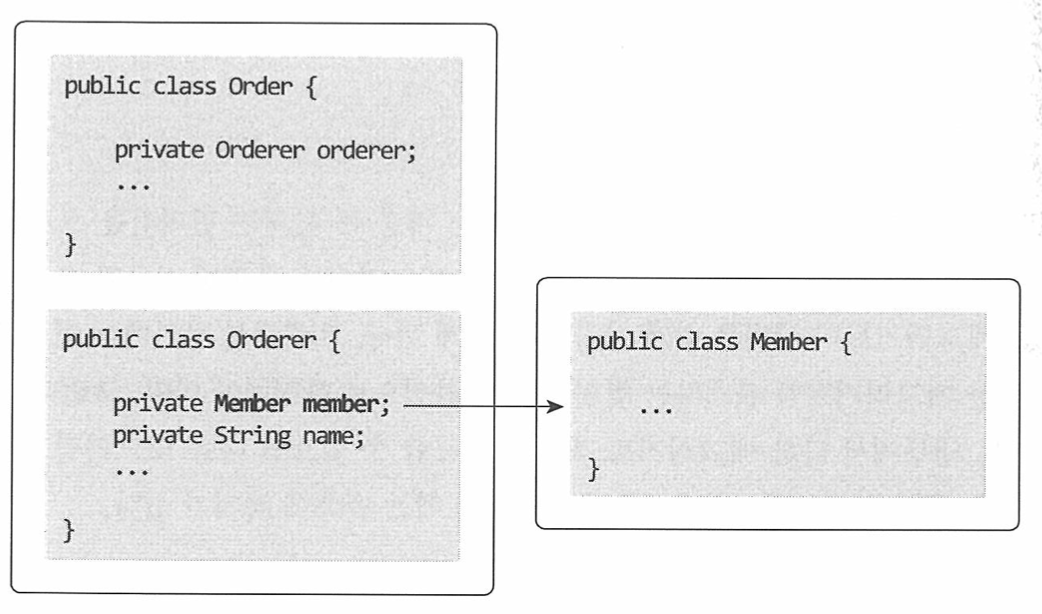Aggregate
- 상위 수준 개념을 이용해서 전체 모델을 정리하면 전반적인 관계를 이해하는 데 도움이 된다.
- 개별 객체 수준에서 모델을 바라보면 전체 모델을 이해하는 데 어려움이 있다.
- 복잡한 도메인을 이해하고 관리하기 쉬운 단위로 만들려면 상위 수준에서 모델을 조망할 수 있는 방법이 필요하다.
Aggreagte는 관련된 객체를 하나의 군으로 묶어준다.



Aggregate 특징
Aggregate와 그에 속한 객체는 유사하거나 동일한 라이프 사이클을 갖는다.- 주문 Aggregate를 만들기 위해서는,
- Order, OrderLine, Orderer와 같은 관련 객체를 함께 생성해야 한다.
- 주문 Aggregate를 만들기 위해서는,
Aggregate는 위 그림에서 보는것 처럼 경계를 갖는다.- 한
Aggregate에 속한 객체는 다른Aggregate에 속하지 않는다. Aggregate는 독립된 군이며, 오로지 자기 자신을 관리할 뿐, 다른Aggregate는 관리하지 않는다.
- 한
Aggregate Root
Aggregate에 속한 모든 객체가 일관된 상태를 유지하려면Aggregate전체를 관리할 주체가 필요하다.- 이 책임을 지는 것이 바로
Aggregate Root이다.
- 이 책임을 지는 것이 바로
Aggregate에 속한 객체는Aggregate Root에 직접 또는 간접적으로 속하게 된다.

Aggregate Root 역할
- 도메인 규칙에 따라
Aggregate의 일관성이 깨지지 않아야 한다. Aggregate가 제공해야 할 도메인 기능을 구현한다.
public class Order {
// Aggregate Root는 도메인 규칙을 구현한 기능을 제공한다.
public void changeShippingInfo(ShippingInfo newShippingInfo) {
verifyNotYetShipped();
setShippingInfo(newShippingInfo);
}
private void verifyNotYetShipped() {
if (state != OrderState.PAYMENT_WAITING && state != OrderState.PREPARING) {
throw new IllegalStateException("already shipped");
}
}
}Aggregate 구현시 주의사항
단순히 필드를 변경하는 set 메서드를 public 범위로 만들지 않는다.
Value타입은 불변으로 구현한다.Value타입 데이터를 변경할 때는 객체 자체를 완전히 교체한다.
- Aggregate 외부에서 Aggregate에 속한 객체를 직접 변경하면 안 된다.
- 데이터 일관성이 꺠지게 된다.
ShippingInfo shippingInfo = order.getShippingInfo();
shippingInfo.setAddress(newAddress);Aggregate Root의 기능 구현
- Aggregate Root는 Aggregate 내부의 다른 객체를 조합해서 기능을 완성한다.
public class Order {
private Money totalAmounts;
private List<OrderLine> orderLines;
private void calculateTotalAmounts() {
int sum = orderLines.stream()
.mapToInt(orderLine -> orderLine.getPrice() * orderLine.getQuantity())
.sum();
this.totalAmounts = new Money(sum);
}
}- Aggregate Root가 구성요소의 상태만 참조하는 것은 아니다.
- 기능 실행을 위임하기도 한다.
public class OrderLines {
private List<OrderLine> lines;
public Money getTotalAmounts() {
// ...
}
// public일 경우, 외부에서 OrderLines의 상태를 변경할 수 있다.
// 오로지 Aggregate Root에서만 변경할 수 있게끔, package 혹은 protected로 설정한다.
protected void changeOrderLines(List<OrderLine> newLines) {
this.lines = newLines;
}
}public class Order {
private Money totalAmounts;
private OrderLines orderLines;
public void changeOrderLines(List<OrderLine> newLines) {
orderLines.changeOrderLines(newLines);
this.totalAmounts = orderLines.calculateTotalAmounts();
}
}Aggregate의 Transaction 범위
- 가급적이면 한 Transaction에서는 하나의 Aggregate만 수정한다.
- 여러 Aggregate를 수정해야 한다면,
Application영역에서 여러 Aggregate를 수정하도록 구현하는 걸 권장한다.
- 여러 Aggregate를 수정해야 한다면,
- Domain 이벤트를 사용하면, 한 Transaction에서 한 개의 Aggregate를 수정하면서도 동기나 비동기로 다른 Aggregate의 상태를 변경하는 것이 가능하다.
Repository, Aggregate
- Aggregate는 개념상 완전한 한 개의 도메인 모델을 표현하므로,
- 객체의 영속성을 처리하는
Repository는 Aggregate 단위로 존재한다.
- 객체의 영속성을 처리하는
Repository는 기본적으로 Aggregate를 저장하고 조회하는 기능을 제공한다.- save
- findById
- 그 외에 검색, 삭제 메서드를 추가할 수 있다.
- Aggregate는 개념적으로 하나 이므로,
Repository는 Aggregate 전체를 저장소에 영속화해야한다.
ID를 이용한 Aggregate 참조
- Aggregate도 다른 Aggregate를 참조한다.
JPA를 활용하여 직접 참조

ID를 활용한 간접 참조

1. 편한 탐색 오용
- 한 Aggregate 내부에서 다른 Aggregate에 접근할 수 있다면,
- 다른 Aggregate의 상태를 쉽게 변경할 수 있다.- 한 Aggregate에서 다른 Aggregate의 상태를 변경하는 것 은 Aggregate 간의 의존 결합도를 높인다.
- 결과적으로 Aggregate의 변경을 어렵게 만든다.
한 Aggregate가 관리하는 범위는 자기 자신으로 한정해야 한다.
public class Order {
private Orderer orderer;
public void changeShippingInfo(ShippingInfo newShippingInfo, boolean useNewShippingAddAsMemberAddress) {
if (useNewShippingAddAsMemberAddress) {
orderer.getMember().changeAddress(newShippingInfo); // Not Good...
}
}
}2. 성능에 대한 고민
- JPA를 활용해서 Aggregate를 직접 참조하면, 성능에 대한 고민을 해야한다.
- Lazy Loading, Eager Loading
3. 확장 어려움
- JPA와 같은 단일 기술에 의존하면, 확장이 어렵다.

ID를 이용한 참조와 조회 성능 문제
- ID를 통한 Aggregate 참조는 조회 성능에 이슈를 발생시킬 수 있다.
- N+1 Query
Member member = memberRepository.findById(ordererId);
List<Order> orders = orderRepository.findByOrderer(ordererId);
List<OrderView> orderViews = orders.stream()
map(order -> {
ProductId productId = order.getOrderLines().get(0).getProductId();
// 각 주문마다 첫 번쨰 주문 상품 정보 로딩을 위한 쿼리 실행 (N+1 쿼리 현상과 비슷)
Product product = productRepository.findById(productId);
return new OrderView(order, member, product);
}).toList();해결방법
- 조회 전용쿼리를 사용하면 된다.
@Repository
public class JpaOrderViewDao implements OrderViewDao {
@Override
public List<OrderView> selectByOrderer(String ordererId) {
// Order, Member, Product 조인 쿼리 수행
// Result 변환
}
}Aggregate 간 집합 연관
Aggregate를 Factory로 사용하기
- 특정 상점이 고객에게 신고당할 경우, Block 된다고 가정하자.
- 상점이 Block 상태가 아닌 경우에만 신규 상품을 생성할 수 있도록 구현해보자.
public class RegisterProductService {
public ProductId registerNewProduct(NewProductRequest req) {
Store store = storeRepository.findById(req.getStoreId());
checkNull(store);
// Store가 Blocked 상태인지 확인
if (store.isBlocked()) {
throw new StoreBlockedException();
}
// Store가 신규 Product 생성
ProductId productId = productRepository.nextId();
Product product = new Producct(productId, store.getId(), ...);
productRepository.save(product);
return product.getId();
}
}- 위 코드는 아래 2가지 코드가 분리되어 있다.
- Store가 신규 Product을 생성할 수 있는지 판단 (Block 상태인지 아닌지 확인)
- Store가 신규 Product 생성
내부 Aggregate 객체에게 위임하거나 다른 Factory에게 위임하기
public class Store {
public Product createProduct(ProductId productId, ProductInfo productInfo) {
if (isBlocked()) {
throw new StoreBlockedException();
}
// return new Product(productId, this.id, productInfo);
return ProductFactory.create(productId, this.id, productInfo);
}
}public class RegisterProductService {
public ProductId registerNewProduct(NewProductRequest req) {
Store store = storeRepository.findById(req.getStoreId());
checkNull(store);
ProductId productId = productRepository.nextId();
Product product = store.createProduct(productId, ...);
productRepository.save(product);
return product.getId();
}
}
